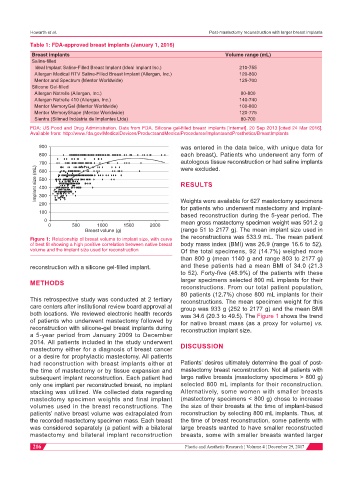Page 223 - Read Online
P. 223
Howarth et al. Post-mastectomy reconstruction with larger breast implants
Table 1: FDA-approved breast implants (January 1, 2016)
Breast implants Volume range (mL)
Saline-filled
Ideal Implant Saline-Filled Breast Implant (Ideal Implant Inc.) 210-755
Allergan Medical RTV Saline-Filled Breast Implant (Allergan, Inc.) 120-800
Mentor and Spectrum (Mentor Worldwide) 125-700
Silicone Gel-filled
Allergan Natrelle (Allergan, Inc.) 80-800
Allergan Natrelle 410 (Allergan, Inc.) 140-740
Mentor MemoryGel (Mentor Worldwide) 100-800
Mentor MemoryShape (Mentor Worldwide) 120-775
Sientra (Silimed Indústria de Implantes Ltda) 80-700
FDA: US Food and Drug Administration. Data from FDA. Silicone gel-filled breast implants [Internet]. 20 Sep 2013 [cited 24 Mar 2016].
Available from: http://www.fda.gov/MedicalDevices/ProductsandMedicalProcedures/ImplantsandProsthetics/BreastImplants
900 was entered in the data twice, with unique data for
800 each breast). Patients who underwent any form of
700 autologous tissue reconstruction or had saline implants
were excluded.
Implant size (mL) 500 RESULTS
600
400
300
200 Weights were available for 627 mastectomy specimens
for patients who underwent mastectomy and implant-
100 based reconstruction during the 5-year period. The
0 mean gross mastectomy specimen weight was 501.2 g
0 500 1000 1500 2000
Breast volune (g) (range 51 to 2177 g). The mean implant size used in
the reconstructions was 533.9 mL. The mean patient
Figure 1: Relationship of breast volume to implant size, with curve
of best fit showing a high positive correlation between native breast body mass index (BMI) was 26.9 (range 16.6 to 52).
volume and the implant size used for reconstruction Of the total specimens, 92 (14.7%) weighed more
than 800 g (mean 1140 g and range 803 to 2177 g)
reconstruction with a silicone gel-filled implant. and these patients had a mean BMI of 34.0 (21.3
to 52). Forty-five (48.9%) of the patients with these
METHODS larger specimens selected 800 mL implants for their
reconstructions. From our total patient population,
80 patients (12.7%) chose 800 mL implants for their
This retrospective study was conducted at 2 tertiary reconstructions. The mean specimen weight for this
care centers after institutional review board approval at group was 933 g (252 to 2177 g) and the mean BMI
both locations. We reviewed electronic health records was 34.6 (20.3 to 49.5). The Figure 1 shows the trend
of patients who underwent mastectomy followed by for native breast mass (as a proxy for volume) vs.
reconstruction with silicone-gel breast implants during reconstruction implant size.
a 5-year period from January 2009 to December
2014. All patients included in the study underwent
mastectomy either for a diagnosis of breast cancer DISCUSSION
or a desire for prophylactic mastectomy. All patients
had reconstruction with breast implants either at Patients’ desires ultimately determine the goal of post-
the time of mastectomy or by tissue expansion and mastectomy breast reconstruction. Not all patients with
subsequent implant reconstruction. Each patient had large native breasts (mastectomy specimens > 800 g)
only one implant per reconstructed breast, no implant selected 800 mL implants for their reconstruction.
stacking was utilized. We collected data regarding Alternatively, some women with smaller breasts
mastectomy specimen weights and final implant (mastectomy specimens < 800 g) chose to increase
volumes used in the breast reconstructions. The the size of their breasts at the time of implant-based
patients’ native breast volume was extrapolated from reconstruction by selecting 800 mL implants. Thus, at
the recorded mastectomy specimen mass. Each breast the time of breast reconstruction, some patients with
was considered separately (a patient with a bilateral large breasts wanted to have smaller reconstructed
mastectomy and bilateral implant reconstruction breasts, some with smaller breasts wanted larger
216 Plastic and Aesthetic Research ¦ Volume 4 ¦ December 29, 2017

